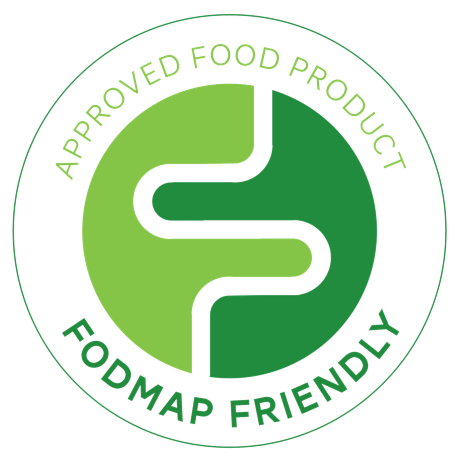What is following the low FODMAP diet really like? A deep dive into myths vs. reality
Posted on July 14, 2021
The low FODMAP diet can be quite overwhelming to begin with, as there are many intricacies and much more attention must be paid to your everyday diet than simply deciding what to eat each day. There is a common misconception that the diet is incredibly limited, however with planning and familiarisation of food products, it doesn’t have to be daunting! Today we are going to do a deep dive into the five commonly posed myths, followed by a breakdown of the reality of following the low FODMAP diet.
Five common myths about the low FODMAP diet
1. “I can’t eat any sugar on the low FODMAP diet”
All FODMAPs are considered ‘sugars’ as opposed to starches because of their short to medium chain lengths, but not all sugars are FODMAPs! Two sugars (Monosaccharides & Disaccharides) of concern on the low FODMAP diet are fructose and lactose. Fructose is a FODMAP when it’s in excess of glucose in food as fructose absorption in the gut is aided by glucose. People tend to report experiencing IBS symptoms when fructose is found in excess of glucose in a food, such as in mangoes and honey. This is why excess fructose is limited on the low FODMAP diet. White sugar or table sugar is made up of equal amounts of the two monosaccharides glucose and fructose. Although white sugar contains fructose, it is fructose is not in excess of glucose and thus it is not high in FODMAPs. The disaccharide of concern on the low FODMAP diet is lactose, commonly known as ‘milk sugar’ as it is found in dairy products.
To summarise – not all sugars are high in FODMAPs! It is important to make use of your FODMAP Friendly App to gain a full list of sugars and their specific serve sizes: Android or Apple (iPhone)
2. “The low FODMAP diet is flavourless”
We hear you – the thought of cooking without garlic and onion is inherently daunting! However, as more people around the world continue to reap the benefits of following a low FODMAP diet to help manage their IBS symptoms, we’re observing more creativity when it comes to developing low FODMAP alternatives to foods & food products that are typically high in FODMAPs. Beyond this, many herbs & spices are also considered low FODMAP and can still be used freely when spicing foods. FODMAP Friendly certified products offer a huge range of low FODMAP products to provide more variety and flavour, allowing you to Eat and Shop with Confidence.
3. “Eating low FODMAP means I can’t eat gluten or dairy
Gluten
Wheat, barley and rye contain both gluten and FODMAPs – namely fructans, which is a type of oligosaccharide (the ‘O’ in FODMAP). The difference is that a gluten-free diet restricts the protein in these grains, while the low FODMAP diet reduces the carbohydrates in these grains. This means that food products that contain small amounts of wheat may be tolerated by someone with IBS, such as wheat biscuits & crackers. Restricting gluten-containing products may restrict your low FODMAP options. Remember that gluten free options can still be high in FODMAPs, such as products made with coconut flour. This is why checking a label is so important, regardless of whether the product is gluten free or not.
Dairy
Lactose is a carbohydrate naturally present in milk. It is also a disaccharide (the ‘D’ in FODMAP) and is commonly malabsorbed sugar in those with IBS. A common misconception of the low FODMAP diet is that all dairy products must be completely eliminated. That is not the case! While lactose should be limited, low FODMAPPERs can still enjoy dairy through a range of low FODMAP lactose free dairy products (hard cheeses, Greek yoghurt etc.). Check out the FODMAP Friendly certified dairy range here.
4. “The low FODMAP diet is a weight loss diet”
The low FODMAP diet is not meant to restrict calories nor aimed at weight loss. The diet focusses on swapping specific High FODMAP foods or large quantities to reduce FODMAP intake rather than energy intake. FODMAP—trained Dietitians typically discourage pursuing active weight loss during the low FODMAP initial & re-introduction phases. Why? Following a low FODMAP diet and losing weight are tasks that require a great deal of attention to dietary patterns and food choices. Tackling both at the same time may decrease your success in achieving either goal. Remember, SMART goals are those that are specific, measurable, attainable, relevant and timely.
5. “The low FODMAP diet is a forever diet”
You’ve completed the elimination phase of the low FODMAP diet and you’re feeling fantastic. Then, your Dietitian asks you to begin your FODMAP challenges. Surely it would just be easier to stay on the low FODMAP diet forever, right? Not so fast! Following a low FODMAP diet is a diagnostic tool, not a forever diet. In fact, many FODMAPs act like prebiotics and have a positive effect on our gut health. It is important to remember that the ‘elimination’ phase is designed to set you up to complete the just-as-important ‘challenge’ phase.
The reality with an overview of the three phases of a traditional low FODMAP diet
The three phases of the low FODMAP diet involve the initial Phase 1 of the low FODMAP diet, Phase 2 is the challenge/reintroduction and Phase 3 is the longer-term personalisation. What are FODMAPs, you ask? Fermentable Oligosaccharides; Disaccharides; Monosaccharides and Polyols. These are the chemical names for several sugars that are poorly absorbed in the small intestine and can cause digestive discomfort. The overall goal of these steps is to identify which FODMAP groups are involved in triggering or exacerbating IBS symptoms, and subsequently use this information to personalise what individuals eat, to ensure as much variety and as little symptoms as possible.
Phase 1. The Initial Phase of the low FODMAP diet
Swapping high FODMAP foods for low FODMAP foods. This is to assess if there is any symptom improvement and usually lasts around two to six weeks (see, far from a forever diet!).
Phase 2. The Re-introduction Phase of the low FODMAP diet
The Re-introduction or Challenge phase is commenced if symptoms have improved following Phase 1. The challenge phase aims to identify which specific FODMAP groups trigger symptoms. It is achieved by identifying individual thresholds, so individuals can still enjoy some poorly tolerated foods in small amounts e.g. ½ a glass of lactose-containing milk. This reduces the need for an over-restrictive elimination-style diet, which can limit foods high in prebiotics and plant variety. The challenge phase is structured and systematic – similar to running an experiment.
Phase 3. The Personalisation Phase of the low FODMAP diet
The Longer-term Personalisation phase may include well tolerated higher FODMAP foods in the diet. It aims to give individuals the knowledge of which foods may give them symptoms but allows them to work to balance symptoms with food desires.
Low FODMAP foods breakdown by food group
Fruits: low FODMAP fruits include but are not limited to unripe bananas, blueberries, dragon fruit, kiwifruit, oranges, mandarins, pineapple, raspberries and strawberries.
Vegetables & Legumes: there are a number of low FODMAP vegetables and legumes, including broccoli heads, cabbage, carrots, tomatoes, cucumber, lettuce, spinach, red capsicum, pumpkin & sweet potato. However, it is important to refer to your FODMAP Friendly App (Android or iPhone) to discern what is considered a low FODMAP serve for each of these vegetables.
Grains: you have a plethora of low FODMAP grains to choose from! Low FODMAP grains include rice, quinoa, Kellogg’s Corn Flakes, millet, Uncle Toby’s Oats, rice cakes and rice crackers. Always be mindful that not all gluten free products are low in FODMAPs, so it is important to double check the ingredient panel. Again, refer to your FODMAP Friendly App for important serve size information!
Meat & Alternatives: beef, chicken, lamb, pork, turkey and seafoods such as canned tuna & fresh fish are on the table of a low FODMAP diet. However, processed, pre-made burgers and sausages are important to watch out for as they may contain high FODMAP additives such as garlic and onion. This goes for vegetarian products too. As for alternatives, firm tofu is a curd made from soybeans, and when firm tofu is produced, many of the FODMAPs leach out into the surrounding liquid, so firm tofu is lower in FODMAPs than silken tofu.
Dairy & Alternatives: as mentioned earlier, lactose is a FODMAP, not dairy as a food group. This means that lactose free dairy is often the way to go, as well as butter, many types of cheeses, eggs and many plant-based milks such as almond and rice milk. Double check when purchasing soy milk, as soy milk made with soy beans is high FODMAP, but soy milk made with soy protein is low FODMAP.
How to find easy alternatives to common high FODMAP foods
When it comes to low FODMAP alternatives to high FODMAP foods, check out fodmapfriendly.com
It is one thing to know what FODMAPs stand for, and another to know what they actually are. Your first port of call should always be a FODMAP-trained Dietitian who will be able to provide personalised advice and education. As well as your Dietitian, reputable websites such as our FODMAP Friendly blog with multiple posts explaining the different letters that make up ‘FODMAPs’. Another great resource is the FODMAP Friendly App for Android or Apple (iPhone), which will help you with low FODMAP serve sizes.
We at FODMAP Friendly are here to help!
 Be sure to clue up by familiarising yourself with any FODMAP Friendly certified products at your local supermarket. You may want to set aside a few hours for your first shopping trip to spend time reading ingredients lists for high FODMAP-containing ingredients such as garlic or onion. When you purchase FODMAP Friendly certified products and consume them in the specified quantity, you can be rest assured that the product has gone through rigorous laboratory testing and can take the headache out of shopping.
Be sure to clue up by familiarising yourself with any FODMAP Friendly certified products at your local supermarket. You may want to set aside a few hours for your first shopping trip to spend time reading ingredients lists for high FODMAP-containing ingredients such as garlic or onion. When you purchase FODMAP Friendly certified products and consume them in the specified quantity, you can be rest assured that the product has gone through rigorous laboratory testing and can take the headache out of shopping.
Have a look at a range of FODMAP Friendly certified products here. Look out for foods such as the FreeFod Onion & Garlic Replacer, Cobram Estate Garlic Infused Extra Virgin Olive Oil and Slightly Different Orange, Ginger & Chilli Salad dressing.
In Summary
There are many fantastic resources to help you break the myths down and see the diet through. Seeing a FODMAP-trained Dietitian is highly recommended to have a good understanding of the diet before starting and to prevent unnecessary over-restriction. Remember that tolerance of specific FODMAPs is highly individualised and embarking on a low FODMAP diet is best done with the guidance of health professionals.
Written by Charlotte Barber (Student Nutritionist)
Reviewed by Kiarra Martindale (Accredited Practising Dietitian)












